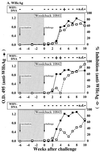Coadministration of gamma interferon with DNA vaccine expressing woodchuck hepatitis virus (WHV) core antigen enhances the specific immune response and protects against WHV infection
- PMID: 11333883
- PMCID: PMC114907
- DOI: 10.1128/JVI.75.11.5036-5042.2001
Coadministration of gamma interferon with DNA vaccine expressing woodchuck hepatitis virus (WHV) core antigen enhances the specific immune response and protects against WHV infection
Abstract
DNA vaccinations are able to induce strong cellular immune responses in mice and confer protection against infectious agents. However, DNA vaccination of large animals appears to be less effective and requires repeated injections of large amounts of plasmid DNA. Enhancement of the efficiency of DNA vaccines may be achieved by coapplication of cytokine-expressing plasmids. Here we investigated, with woodchucks, whether coadministration of an expression plasmid for woodchuck gamma interferon (IFN-gamma), pWIFN-gamma, can improve DNA vaccination with woodchuck hepatitis virus core antigen (WHcAg). Animals were immunized with pWHcIm (a plasmid expressing WHcAg) alone or with a combination of pWHcIm and pWIFN-gamma using a gene gun. Six weeks postimmunization, all animals were challenged with 10(5) genome equivalents of woodchuck hepatitis virus (WHV). The antibody and lymphoproliferative immune responses to WHV proteins were determined after immunization and after challenge. Vaccination with pWHcIm and pWIFN-gamma led to a pronounced lymphoproliferative response to WHcAg and protected woodchucks against subsequent virus challenge. Two of three animals vaccinated with pWHcIm alone did not show a detectable lymphoproliferative response to WHcAg. A low-level WHV infection occurred in these woodchucks after challenge, as WHV DNA was detectable in the serum by PCR. None of the pWHcIm-vaccinated animals showed an anti-WHcAg antibody response after DNA vaccination or an anamnestic response after virus challenge. Our results indicate that coadministration of the WIFN-gamma gene with pWHcIm enhanced the specific cellular immune response and improved the protective efficacy of WHV-specific DNA vaccines.
Figures





Similar articles
-
Protection against woodchuck hepatitis virus (WHV) infection by gene gun coimmunization with WHV core and interleukin-12.J Virol. 2001 Oct;75(19):9068-76. doi: 10.1128/JVI.75.19.9068-9076.2001. J Virol. 2001. PMID: 11533170 Free PMC article.
-
Immunization with the gene expressing woodchuck hepatitis virus nucleocapsid protein fused to cytotoxic-T-lymphocyte-associated antigen 4 leads to enhanced specific immune responses in mice and woodchucks.J Virol. 2005 May;79(10):6368-76. doi: 10.1128/JVI.79.10.6368-6376.2005. J Virol. 2005. PMID: 15858020 Free PMC article.
-
Immunization of woodchucks with plasmids expressing woodchuck hepatitis virus (WHV) core antigen and surface antigen suppresses WHV infection.J Virol. 1999 Jan;73(1):281-9. doi: 10.1128/JVI.73.1.281-289.1999. J Virol. 1999. PMID: 9847331 Free PMC article.
-
Evaluation of new approaches to prophylactic and therapeutic vaccinations against hepatitis B viruses in the woodchuck model.Intervirology. 2001;44(2-3):124-31. doi: 10.1159/000050039. Intervirology. 2001. PMID: 11509873 Review.
-
The woodchuck: a model for therapeutic vaccination against hepadnaviral infection.Pathol Biol (Paris). 2010 Aug;58(4):308-14. doi: 10.1016/j.patbio.2010.04.005. Epub 2010 Jun 19. Pathol Biol (Paris). 2010. PMID: 20646874 Review.
Cited by
-
Nucleic acid vaccines: A taboo broken and prospect for a hepatitis B virus cure.World J Gastroenterol. 2021 Nov 7;27(41):7005-7013. doi: 10.3748/wjg.v27.i41.7005. World J Gastroenterol. 2021. PMID: 34887624 Free PMC article.
-
Bicistronic woodchuck hepatitis virus core and gamma interferon DNA vaccine can protect from hepatitis but does not elicit sterilizing antiviral immunity.J Virol. 2007 Jan;81(2):903-16. doi: 10.1128/JVI.01537-06. Epub 2006 Nov 1. J Virol. 2007. PMID: 17079319 Free PMC article.
-
Woodchuck gamma interferon upregulates major histocompatibility complex class I transcription but is unable to deplete woodchuck hepatitis virus replication intermediates and RNAs in persistently infected woodchuck primary hepatocytes.J Virol. 2002 Jan;76(1):58-67. doi: 10.1128/jvi.76.1.58-67.2002. J Virol. 2002. PMID: 11739671 Free PMC article.
-
Emerging drugs for hepatitis B.Expert Opin Emerg Drugs. 2007 May;12(2):199-217. doi: 10.1517/14728214.12.2.199. Expert Opin Emerg Drugs. 2007. PMID: 17604497 Free PMC article. Review.
-
Protective antiviral immune responses to pseudorabies virus induced by DNA vaccination using dimethyldioctadecylammonium bromide as an adjuvant.J Virol. 2002 Oct;76(20):10540-5. doi: 10.1128/jvi.76.20.10540-10545.2002. J Virol. 2002. PMID: 12239334 Free PMC article.
References
-
- Bohm W, Kuhrober A, Paier T, Mertens T, Reimann J, Schirmbeck R. DNA vector constructs that prime hepatitis B surface antigen-specific cytotoxic T lymphocyte and antibody responses in mice after intramuscular injection. J Immunol Methods. 1996;193:29–40. - PubMed
-
- Bohm W, Mertens T, Schirmbeck R, Reimann J. Routes of plasmid DNA vaccination that prime murine humoral and cellular immune responses. Vaccine. 1998;16:949–954. - PubMed
-
- Chow Y H, Chiang B L, Lee Y L, Chi W K, Lin W C, Chen Y T, Tao M H. Development of Th1 and Th2 populations and the nature of immune responses to hepatitis B virus DNA vaccines can be modulated by codelivery of various cytokine genes. J Immunol. 1998;160:1320–1329. - PubMed
-
- Cote P J, Roneker C, Cass K, Schodel F, Peterson D, Tennant B, De Noronha F, Gerin J. New enzyme immunoassays for the serologic detection of woodchuck hepatitis virus infection. Viral Immunol. 1993;6:161–169. - PubMed
Publication types
MeSH terms
Substances
LinkOut - more resources
Full Text Sources
Other Literature Sources
Medical

